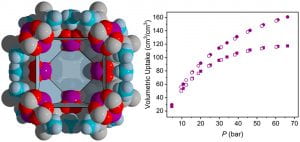Understanding Gas Storage in Cuboctahedral Porous Coordination Cages

Bloch Group recently published a paper in JACS where neutron diffraction was used to study methane binding sites in porous materials
Gregory R. Lorzing, Eric J. Gosselin, Benjamin A. Trump, Arthur H. P. York, Arni Sturluson, Casey A. Rowland, Glenn P. A. Yap, Craig M. Brown, Cory M. Simon, Eric D. Bloch*
Porous molecular solids are promising materials for gas storage and gas separation applications. However, given the relative dearth of structural information concerning these materials, additional studies are vital for further understanding their properties and developing design parameters for their optimization. Here, we examine a series of isostructural cuboctahedral, paddlewheel-based coordination cages, M24(tBu-bdc)24 (M = Cr, Mo, Ru; tBu-bdc2– = 5-tert-butylisophthalate), for high-pressure methane storage. As the decrease in crystallinity upon activation of these porous molecular materials precludes diffraction studies, we turn to a related class of pillared coordination cage-based metal–organic frameworks, M24(Me-bdc)24(dabco)6 (M = Fe, Co; Me-bdc2– = 5-methylisophthalate; dabco = 1,4-diazabicyclo[2.2.2]octane) for neutron diffraction studies. The five porous materials display BET surface areas from 1057–1937 m2/g and total methane uptake capacities of up to 143 cm3(STP)/cm3. Both the porous cages and cage-based frameworks display methane adsorption enthalpies of −15 to −22 kJ/mol. Also supported by molecular modeling, neutron diffraction studies indicate that the triangular windows of the cage are favorable methane adsorption sites with CD4–arene interactions between 3.7 and 4.1 Å. At both low and high loadings, two additional methane adsorption sites on the exterior surface of the cage are apparent for a total of 56 adsorption sites per cage. These results show that M24L24 cages are competent gas storage materials and further adsorption sites may be optimized by judicious ligand functionalization to control extracage pore space.

